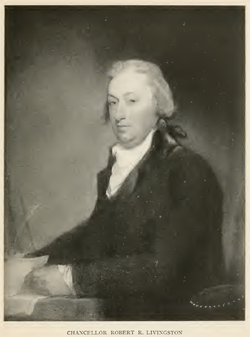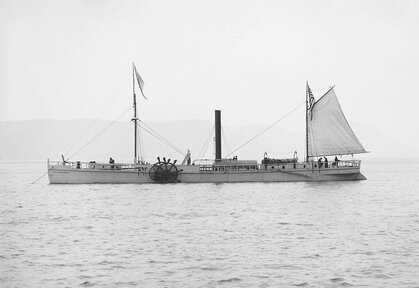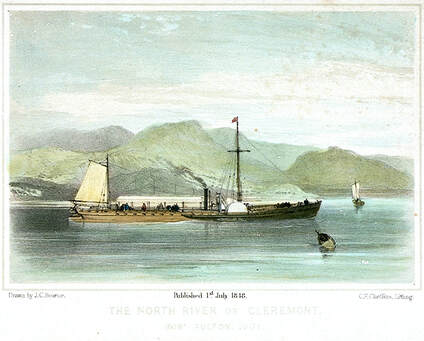Robert Fulton
and
the Steamboat

Robert Fulton is often referred to as the inventor of the steamboat, which is an oversimplification of a complex issue, as is often the case with the bestowal of the first- to-invent title. Fulton was not the first person to build an operable steamboat and was not the first person to receive a patent for a steamboat. Fulton's achievement was being the first person to build a practical and commercially successful steamboat, the "North River Steamboat", now commonly referred to as the "Clermont".
Although Fulton had already been thinking about steamboats way back in 1777 when he was just 12 years old, the origins of the Clermont can be traced to Paris in 1802. At the time, Fulton was in Paris trying to sell the French on "a Universal betterment of Humanity, through a constructive system of Canals, and a destructive system of Torpedoes." The word "torpedo" was coined by Fulton to describe an explosive charge carried by a submarine and placed against the bottom of an enemy ship.
In an attempt to convince Napoleon to invest in his ideas, Fulton built a number of torpedoes, as well as a submarine called the Nautilus, which is generally considered to have been the first practical submarine. The Nautilus and the torpedoes were all tested successfully, but Napoleon declined to provide Fulton with any funding upon the advice of his scientific counselers, who considered Fulton's inventions to be "mad scheme[s]" and "simple absurdity".
Although Fulton had already been thinking about steamboats way back in 1777 when he was just 12 years old, the origins of the Clermont can be traced to Paris in 1802. At the time, Fulton was in Paris trying to sell the French on "a Universal betterment of Humanity, through a constructive system of Canals, and a destructive system of Torpedoes." The word "torpedo" was coined by Fulton to describe an explosive charge carried by a submarine and placed against the bottom of an enemy ship.
In an attempt to convince Napoleon to invest in his ideas, Fulton built a number of torpedoes, as well as a submarine called the Nautilus, which is generally considered to have been the first practical submarine. The Nautilus and the torpedoes were all tested successfully, but Napoleon declined to provide Fulton with any funding upon the advice of his scientific counselers, who considered Fulton's inventions to be "mad scheme[s]" and "simple absurdity".

While in Paris, Fulton met Robert Livingston, who, at the time, was the U.S. ambassador to France. Livingston shared Fulton's vision that steamboats were the future of maritime transportation. On October 10, 1802, the two like-minded men entered into a formal agreement to build and operate a steamship on the Hudson river, between New York and Albany.
In furtherance of his arrangement with Livingston, Fulton built two prototype steamboats, which he tested on the Seine river in the summer of 1803. The first prototype broke in two and sank, but was salvaged and used to build the second prototype. The second prototype had a strengthened hull and was successfully tested on August 9, 1803. The successful prototype had most of the defining characteristics of the later Clermont, namely a steam engine located midship, which was connected to drive a pair of paddle wheels located forward of the steam engine and disposed on opposing sides of the boat.
In response to an invitation from the British government, Fulton left France in 1804 and traveled to London to make a proposal for the development of his submarine torpedo system. Fulton's proposal was accepted and he spent the next two years in England working on the system and promoting its adoption by the British Navy. During that time, Fulton also arranged, with some difficulty, to have the firm of Bolton & Watt build a steam engine for the Clermont.
After the death of British Prime Minister, William Pitt (the younger), and the retirement of First Lord of the Admiralty, Lord Melville (Henry Dundas), Fulton was left without any supporters in the British government. Soon thereafter, Fulton's arrangement with the British government was terminated and the adoption of his submarine torpedoes was halted. After settling his accounts in London, Fulton left for the United States, wryly noting to a friend: "My situation now is, my hands are free to burn, sink and destroy whom I please, and I shall now seriously set about giving liberty to the seas by publishing my system of attack".
In furtherance of his arrangement with Livingston, Fulton built two prototype steamboats, which he tested on the Seine river in the summer of 1803. The first prototype broke in two and sank, but was salvaged and used to build the second prototype. The second prototype had a strengthened hull and was successfully tested on August 9, 1803. The successful prototype had most of the defining characteristics of the later Clermont, namely a steam engine located midship, which was connected to drive a pair of paddle wheels located forward of the steam engine and disposed on opposing sides of the boat.
In response to an invitation from the British government, Fulton left France in 1804 and traveled to London to make a proposal for the development of his submarine torpedo system. Fulton's proposal was accepted and he spent the next two years in England working on the system and promoting its adoption by the British Navy. During that time, Fulton also arranged, with some difficulty, to have the firm of Bolton & Watt build a steam engine for the Clermont.
After the death of British Prime Minister, William Pitt (the younger), and the retirement of First Lord of the Admiralty, Lord Melville (Henry Dundas), Fulton was left without any supporters in the British government. Soon thereafter, Fulton's arrangement with the British government was terminated and the adoption of his submarine torpedoes was halted. After settling his accounts in London, Fulton left for the United States, wryly noting to a friend: "My situation now is, my hands are free to burn, sink and destroy whom I please, and I shall now seriously set about giving liberty to the seas by publishing my system of attack".
 Replica of the Clermont built in 1909
Replica of the Clermont built in 1909
Fulton arrived in the United States in late 1806 and immediately set upon building the Clermont. He contracted with Charles Browne, a noted shipbuilder in New York to build the hull of the Clermont. As the Clermont was being built, throngs of people gathered at Browne's shipyard to ridicule the boat, calling it "Fulton's Folly". At one point, Fulton had to hire guards to protect the Clermont from threatened harm.
When completed, the Clermont was 150 feet long, 13 feet wide and drew only 2 feet of water. Like its French predecessors, the Clermont had its steam engine located midship. It was also connected to drive a pair of paddle wheels located forward of the steam engine and disposed on opposing sides of the boat. Both the steam engine and the paddle wheels were uncovered and exposed for all to see. A straight black chimney extended upward from the steam engine and was positioned between a foremast with square sail and a mizzen mast with fore and aft sails. The Clermont was steered by a simple tiller located at the stern of the boat.
On August 17, 1807, the Clermont left from a dock in what is now Greenwich Village and traveled up the Hudson River to Albany, under the helm of Captain Andrew Brink. Two days later, the Clermont arrived in Albany. The time for the trip included 32 hours of travel time and a 20-hour stop at Livingston's estate, Clermont Manor; and yes, this was the origin of the name Clermont. The return trip to New York was completed in 30 hours, with only a one-hour stop at Clermont. The travel time of the Clermont between New York and Albany was roughly one-quarter of the time the trip took by a sailing vessel. The era of the steamship had begun!
When completed, the Clermont was 150 feet long, 13 feet wide and drew only 2 feet of water. Like its French predecessors, the Clermont had its steam engine located midship. It was also connected to drive a pair of paddle wheels located forward of the steam engine and disposed on opposing sides of the boat. Both the steam engine and the paddle wheels were uncovered and exposed for all to see. A straight black chimney extended upward from the steam engine and was positioned between a foremast with square sail and a mizzen mast with fore and aft sails. The Clermont was steered by a simple tiller located at the stern of the boat.
On August 17, 1807, the Clermont left from a dock in what is now Greenwich Village and traveled up the Hudson River to Albany, under the helm of Captain Andrew Brink. Two days later, the Clermont arrived in Albany. The time for the trip included 32 hours of travel time and a 20-hour stop at Livingston's estate, Clermont Manor; and yes, this was the origin of the name Clermont. The return trip to New York was completed in 30 hours, with only a one-hour stop at Clermont. The travel time of the Clermont between New York and Albany was roughly one-quarter of the time the trip took by a sailing vessel. The era of the steamship had begun!
Fulton obtained two patents for his steamboat invention: X996, dated February 11, 1809 and X1435, dated February 9, 1811. The patents are prefixed with an "X" to indicate that they are part of the group of patents issued by the U.S. Patent Office from July 1790 to July 1836, all of which were burned in the U.S. Patent Office fire of December 1836. While the originals of these patents are gone, enough information about them exists to give us an idea of what they claimed. One of the main features that was claimed in the X996 patent was the use of a water wheel in a steamboat. There is some evidence that this claim was not valid in light of the work of Samuel Morey in the late 1700s.


